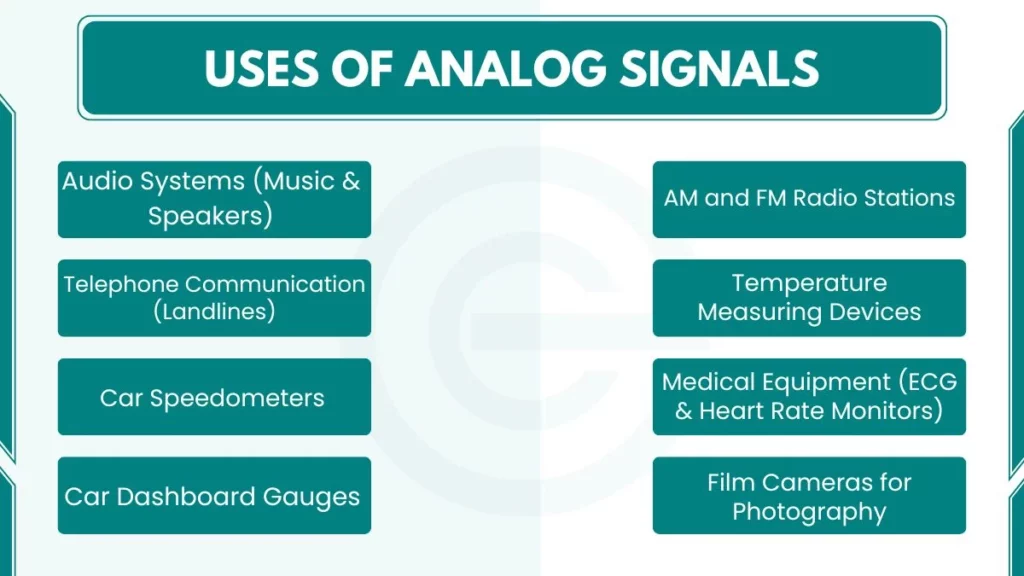Music Systems use analog signals to produce warm, natural sound. Telephone Networks rely on analog signals to carry voice conversations through traditional landline connections.
Radio Broadcasting transmits music and news using AM/FM analog signal through the air. Below we will look at more uses of analog signals in detail.
Uses of Analog Signals in Daily Life
The following are different uses of analog signals in everyday life:

1. Audio Systems (Music & Speakers)
Music systems like speakers and headphones often use analog signals. When you play music on a record player, the needle moves along grooves in the vinyl. These grooves are physical representations of sound waves. The movement creates electrical signals that become the music you hear.
Many people think analog music sounds warmer and more natural than digital music. This is why some musicians still record their songs using analog equipment. The signals flow smoothly without the tiny steps that digital music has.
2. Telephone Communication (Landlines)
Old-fashioned landline phones work with analog signals. When you speak into the phone, your voice makes a microphone vibrate. These vibrations turn into electrical waves that travel through wires. At the other end, another phone changes the waves back into sound.
These phones don’t need internet to work. They can still function during power outages if they get power from the phone line.
3. AM and FM Radio Stations
Radio stations send music and news through the air using analog signals. AM radio changes the height (amplitude) of the waves to carry sound. FM radio changes how close together the waves are (frequency). FM usually sounds clearer because it handles noise better.
When you turn your radio dial, you find different analog signals in the air. The radio in your car catches these waves and turns them into the sounds you hear.
4. Television (Older CRT TVs & Analog Cable)
Televisions used to work only with analog signals. The TV antenna would catch these signals from the air. The strength of the signal affected how clear the picture looked. People often had to adjust their antennas to get better reception.
Some countries still use analog TV signals in remote areas. The signals can travel farther than digital signals in places with few towers. Many older TVs in schools and hospitals still use analog connections.
5. Temperature Measuring Devices
Glass thermometers with mercury inside use analog signals. The liquid moves up or down as temperature changes. The numbers on the side show the exact temperature. Doctors often use these because they don’t need batteries.
Another type is a dial thermometer with a pointer that moves. These are common in ovens and car engines. They give quick temperature readings without any digital display.
6. Car Speedometers with Moving Needles
Many cars show speed with a needle that moves across numbers. As the car goes faster, the needle moves higher. This is an analog display because the needle moves smoothly without jumps.
Drivers can see their speed quickly with just a glance. Some people prefer these over digital numbers because it’s easier to notice small speed changes.
7. Light Dimmers and Volume Controls
Lights with dimmer switches use analog signals. When you turn the knob, the lights get brighter or dimmer smoothly. There are no fixed steps like with digital controls. The same works for volume knobs on older radios and amplifiers.
Restaurants and homes use these to set the perfect light level. The smooth change is easier on the eyes than sudden bright digital lights.
8. Film Cameras for Photography
Traditional cameras use film that captures light in an analog way. Light hits chemicals on the film and makes an image. There are no pixels like in digital cameras. Many photographers say film pictures look more natural.
Some artists still use film cameras because they like the special look. Film also lasts longer than digital files if stored properly.
9. Heart Monitoring Machines in Hospitals
Doctors use ECG machines to check heartbeats. These machines show the heartbeat as a wavy line moving across the screen. The line is an analog signal that shows every small change in the heart’s rhythm.
Nurses can spot problems quickly by looking at the shape of the waves. The continuous line gives more detail than numbers alone could show.
10. Car Dashboard Gauges
Older cars have analog gauges for fuel levels and engine temperature. A needle moves between E (empty) and F (full) to show gas. Another needle shows if the engine is getting too hot.
Drivers can see at a glance if something is wrong. The smooth movement helps notice small changes better than digital numbers that jump.
